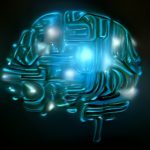The number of AI applications is growing rapidly with use cases getting increasingly fascinating. While most attention in 2023 is focused on generative AI such as Open AI’s ChatGPT or DALL E, this article is not meant to show you how to create a bunch of cat images. Instead, we will give you an overview by exploring 10 captivating and powerful AI applications that are relevant not only in rare business cases but for society as a whole.
1. Lip-Reading
The ability of AI to interpret human language is extending beyond speech recognition. Algorithms to detect lip movements are getting incredibly accurate, opening doors for new applications. Those include:
- Assisting existent speech recognition technology in generating precise subtitles during digital meetings (e.g., Zoom or Microsoft Teams).
- Improving the everyday life of deaf or hear-impaired people.
- Identifying emotions by analyzing facial muscles.
- Facilitating criminal investigations by evaluating video material lacking audio quality.
While identifying threats by analyzing people in public areas may enhance security standards, such systems also bear the risk of being abused for large-scale public surveillance. Thus, authoritarian states may benefit as they gain a deeper understanding of what their population is up to.
2. Cancer Detection
AI can distinguish between benign and malignant tumors in a medical image. In fact, it can do it much more accurately than experienced physicians. This is because the basic architecture of many AI algorithms relies on Neural Networks which can generally be trained to recognize certain patterns in visual recordings. Once the system is familiar with thousands of tumor images it can detect similar patterns in new images. This enables faster and more accurate cancer diagnoses which can save millions of cancer patients as they are more likely to receive treatment at an early stage.
3. Color Black and White Pictures
Remember the time when pictures and movies were only available in black and white? Then, you have probably wondered sometimes what the true colors might be. Well, now you can find out since AI is bringing color to the past.
Specifically, algorithms are able to color:
- Old black and white movies as well as pictures
- Microscopic images of genomes
- And macroscopic images of the universe such as distant galaxies
4. Speech Recognition and Voice Creation
Voice assistants such as Alexa, Google, and Siri have been around for quite some time. While a little buggy at first, they are now able to filter out a specific voice in a crowded room with lots of conversations.
In addition, a fascinating AI application is to reproduce speech with a certain voice. Hence, after recording your own voice for a few minutes, deep learning algorithms indeed “learn” the aspects of your personal voice and can predict how sentences would sound if they came out of your own mouth.
Pros: The generation of voice facilitates the production of audio content. For instance, the active recording of podcasts and audiobooks would become unnecessary once the desired voice is stored in the system. Then, only the text is needed to produce any audio content. Therefore, you might be able to have your book on Audible read by Darth Vader or your favorite actor in the future. In addition, this creates a whole new market for trading famous voices and challenges the legal landscape as people may want to retain the rights to their own speech even if produced by others.
Cons: Creating speech is one element that contributes to deep fakes that are getting increasingly realistic in 2023. Not only pictures such as of Trump’s arrest can be faked also videos containing speech that is indistinguishable from a real person have already been produced. You can find for example a new interview given by Michael Schumacher that never actually happened.
Another Black-Mirror-like scary scenario arises if someone stores the voice of a close person who died. In combination with other technologies, this dead person could artificially be brought back to life with even the same voice that relatives are familiar with.
5. Recognizing and Creating Images
In addition to cancer detection, AI can be trained to recognize all sorts of images. While the first convolutional neural networks (CNN) were developed in the 1990s, it took some time to train them to classify images of animals. In 2012, the CNN AlexNet outperformed other neural nets in a competition and was able to accurately tell whether an image shows a cat, a bird, or any other animal.
Face Recognition
Nowadays, many smartphone users benefit from face recognition to quickly unlock their phones or access their accounts on social media or their banks. This not only increased convenience but also security standards. In fact, the human face has numerous individual characteristics that are learned. Hence, the AI can recognize faces even if they are not fully displayed.
Autonomous Driving
For autonomous vehicles to work, the car is required to detect what the objects in front of it are. Is it a tree, a red traffic light, another car, or a kid running after a ball? This crucial task is taken over by AI which ensures that objects are correctly classified.
Image Generation
Letting AI create images is one of the most recent breakthroughs in AI research. For long it has been debated how algorithms can be creative, especially creative enough to keep up with humans. While the latter remains open for discussion, it is the speed in particular that exceeds human capacities. A short description and one click suffice to generate several images in any style desired. This includes photo-realistic images of people or even artwork. The AI captures every detail of the description, adds its own creativity, and generates the image.
As a result, AI exhibitions in museums are no longer a rarity. Even personalized pictures that look as if they were shot by a professional photographer can easily be generated based on uploaded selfies. Apps like Remini let you even choose the setting and only require a few pictures of yourself.
6. Translations
You probably remember the time when you tried to translate a sentence with Google and the result was complete trash. This was before Google switched from a system that matches each word separately to an AI that understands the meaning and context of what the user intends to convey.
Meanwhile, modern translators such as DeepL and Google rely on neural networks that are not only faster but also deliver more accurate translations. Interestingly, longer translations tend to be more accurate than single words. Therefore, to get the true meaning of a specific word try to provide context and type in a whole sentence instead.
But 2023 has more to offer. Not only can online meeting software such as Teams generate the precise subtitles and take notes, also videos can be translated while maintaining the speaker’s original voice. Universal translators such as Heygen allow to translate videos in any language. Even lip movements and light are adjusted so they match the translations.
Videos can be translated while maintaining the speaker’s original voice and lip movements:
7. Finance AI Applications
A major area for fascinating AI applications is finance. Due to its ability to analyze vast amounts of data in almost real-time, AI in finance has powerful implications in a variety of ways.
Investing
While some economic theories deny the idea of identifying single companies that are under or overvalued by the stock market, many financial institutions employed AI in their analyses. These include market forecasting, portfolio optimization, risk assessments, simulated stress tests, high-frequency trading, market-making, or analyzing text in news articles to spot potential threats.
Financial Crime
Both banks and regulatory authorities can take advantage of AI applications. Thus, by evaluating transaction histories and movements on the markets, financial institutions and supervisors can detect unusual or suspicious patterns and anomalies. Consequently, fraudulent activities such as money laundering, insider trading, and tax avoidance can be uncovered.
Customer Churn Prediction
As banking conditions are largely homogenous, banks face tough competition for their customers. Therefore, retaining customers is essential. This is where Machine Learning comes in handy to predict customer churn. Thus, banks know who is about to terminate their account before the customer knows. For example, based on their transaction activity, banks can assess who to contact before an account is actually cancelled.
8. Biology AI Applications
Biology is one of the most captivating fields for AI applications, especially in the near future. In a nutshell, AI algorithms help process a tremendous amount of data enabling applications science fiction movies can only dream of.
Drug Discovery
Deep Learning algorithms can help understand the mechanisms of a disease. This speeds up the process of finding, developing, and testing appropriate medicine. In addition, simulating the interaction between larger molecules not only saves time but also substantial research costs while reducing the risks in experiments involving real patients.
As this technology continues to get more affordable, even fully personalized drugs can be developed in the future. Consequently, undesired side effects that arise from the differences between humans can be avoided.
Genetic Engineering
Speaking of personalized, AI has the potential to modify each individual characteristic in the human genetic code. In fact, AI serves as a complement to CRISPR-CAS9 which is the fundamental technology to cut and replace targeted genetic sequences. However, to ensure this tool works as intended, sophisticated AI models need to jump in.
AI systems might find a way to alter every human detail from resistance to diseases to adjusting physical appearance such as height, skin, eye color, and even intelligence. While we have manipulated plants for more than 10,000 years (since 1983 even directly through gene editing), humans already joined the club. Whether this contradicts evolution or is even a natural stage and what implications are associated with that will be addressed in a different post.
Predicting Evolution
Ignoring human interventions for a second, artificial intelligence is developed to predict the path of evolution. While long-term predictions are subject to a plethora of factors, estimates about which species will evolve or distinct are rather uncertain. On the other hand, short-term computations can reveal the attributes of your unborn child including genetic diseases or its susceptibility to other diseases, physical appearance and even personal traits may follow in the future. Of course, not everything is determined by one’s genetic predisposition, which is why accuracy is limited.
9. Weather and Wildfire Spread Prediction
The mundane portrayal in the media may obscure it, but the weather is also predicted using real-time data processed by state-of-the-art algorithms. This does not only tell you when to bring an umbrella but is crucial in preparing for natural disasters. Moreover, the recent wildfire incidents across southern Europe have paved the way for new AI applications in 2023. Therefore, systems are being developed to predict occurrences of wildfire and their spread which enables authorities to act fast and respond effectively.
10. Combined AI technologies
Paradoxically, new AI applications arise by combining them unfolding enormous synergy effects. Hence, algorithms may be able to interact, cooperate, and even conduct their own independent research. An example of how algorithms learn to cooperate is shown in this video.
AI agents learn to cooperate:
Putting the components of AI applications together can result in both a blessing and a curse. In China, for example, there exist digital stars i.e. people without a real identity since their voice and appearance are completely artificial. Those “individuals” may become more realistic and independent as AI progresses. On the other side, China has implemented a giant surveillance system that tracks the movement, behavior, and interests of people. In the future, social scoring may be enhanced once more states make use of AI applications such as lip-reading in public spaces.
Maybe we will watch movies in the future that involve actors who are entirely AI-generated. However, it is hard to anticipate what future AI applications will look like and what their implications will be.
Which AI applications were new to you? Let us know in the comments below!








